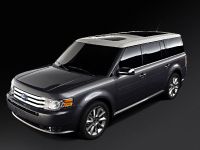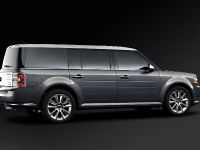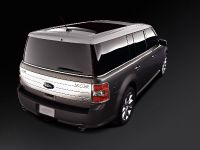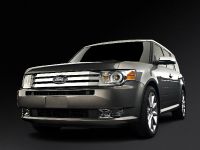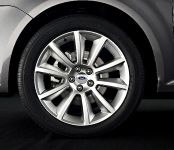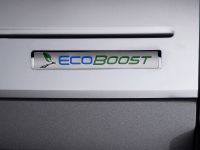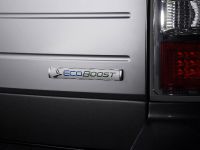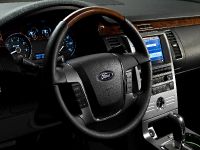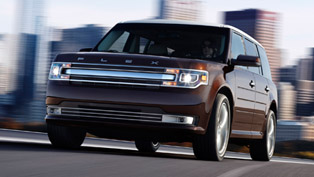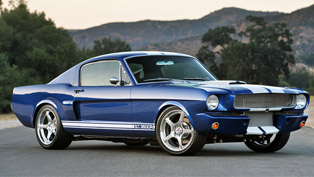Ford's Ecoboost Turbochargers - High Altitude Power Showcase
Advanced twin turbochargers rev up the power of the new 3.5-liter EcoBoost™ V-6 engines that will be available on several vehicles, including the 2010 Ford Flex, later this summer.
Customers already are excited that the lighter-weight, all-aluminum 3.5-liter EcoBoost V-6 delivers the power of a high-powered V-8 engine while maintaining V-6 fuel economy. Extensive testing of the powertrain ensures that the EcoBoost engine meets customer demands – such as passing traffic or towing – seamlessly and effortlessly in any condition.
"EcoBoost technology takes a proven and reliable engine and turns it into an advanced performance powertrain," said Brett Hinds, advanced engine design and development manager. "It doesn't matter whether the customer drives a Lincoln MKS luxury sedan or MKT crossover, the Taurus SHO or the Ford Flex crossover. These are different vehicles with potentially different customer desires. In each case, however, the customer can be assured that EcoBoost engines deliver seamless performance."
Flex with EcoBoost ideal for high-altitude towing
The "boost" part of EcoBoost comes from the twin turbochargers, which recover energy from the exhaust that otherwise would be wasted and put it back in the engine to gain efficiency. Simply put, the turbocharging system forces more air into the engine for more power. A compressor increases or "boosts" the pressure of the air entering the engine.
The two turbochargers both operate identically over the speed range of the engine – one gets its energy from the left bank, the other from the right. Both feed together into the engine, and both spin immediately and produce boost, even at low engine speeds.
Even at altitudes far above sea level, EcoBoost-equipped vehicles maintain their performance, thanks in part to those two turbochargers.
"Other naturally aspirated vehicles would gasp for air, just as a runner would find it more difficult going up Pikes Peak," said Keith Plagens, turbo system engineer. "Having two turbochargers with our EcoBoost engine allows it to breathe effortlessly at higher altitudes."
All EcoBoost V-6 engines maintain peak torque capability at well over 5,000 feet above sea level, making EcoBoost-equipped vehicles ideal for high-altitude operation. Additionally, those Flex customers who opt for towing packages have the assurance that their crossovers can tow up to 4,500 pounds seamlessly because of the abundance of low-end torque. The Flex EcoBoost engine delivers 350 ft.-lb. of torque, which is more torque that a 5.3-liter Chevrolet Tahoe, and because the power is delivered at 1,500 rpm, it offers superior fuel economy as well.
"Customers towing with EcoBoost-equipped vehicles will have a much better towing experience," Plagens said. "Sometimes these customers don't have a lot of experience towing, but the EcoBoost engine will give them more power off the line and help them feel more confident and more in control."
Key facts about the twin turbochargers in the 3.5-liter EcoBoost V-6 engine include:
- They are the first application of twin turbochargers in a Ford vehicle
- For durability, turbochargers are designed for a life cycle of 150,000 miles or 10 years
- Uses water cooling to protect the turbocharger bearings. The water cooling system prevents the phenomenon known as oil coking, in which oil in previous-generation turbo bearings would bake and solidify, causing premature bearing failures
- Unlike previous generations of turbocharger technology, no idling is needed at key off
- Extensive durability testing included one test that lasted 150 hours as part of thermal validation. Every 10 minutes the test alternating between peak power at maximum exhaust temperature and completely cold motoring
- Allows the EcoBoost V-6 to swallow about 25 percent more air than its normally aspirated cousin, the 3.5-liter Duratec V-6
- The turbochargers are packaged adjacent to the cylinder block and have improved mounting, which provides NVH (noise, vibration and harshness) improvements
- Two parallel turbochargers with direct fuel injection reduce turbo lag to imperceptible levels so customers get the power they need as soon as they step on the gas pedal
- Exhaust gas flowing through the turbo spins the turbine wheel at roughly 170,000 rpm
"Thanks in part to the twin turbochargers, the 3.5-liter EcoBoost V-6's tremendous low-end torque provides smooth power on demand, as well as excellent launch and acceleration," said Hinds.
